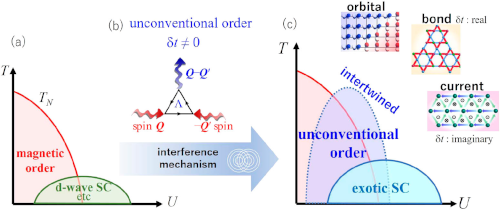Unconventional density waves and superconductivities in Fe-based superconductors and other strongly correlated electron systems
H. Kontani, R. Tazai, Y. Yamakawa, and S. Onari,
Advances in Physics 70, 355 (2021).
Published online: 10 Jan 2023
In this article, we review the recent significant progress in the theoretical studies of the electronic states by mainly focusing on Fe-based and cuprate superconductors. These superconductors are “unconventional” in that strong electron-electron correlation mediates the pairing; they are different from conventional phonon-mediated BCS superconductors. To seek the high-Tc pairing mechanism, many scientists have focused on the mysterious spontaneous rotational symmetry breaking above Tc, such as nematic order at q=0 and smectic order at q≠0. Such exotic correlation-driven symmetry breaking in metals has become a central issue in condensed matter physics. We demonstrate the emergence of the nematic and smectic orders due to orbital polarization ( nxz≠nyz) and the symmetry breaking in the correlated inter-site hopping (= bond order δti,j) in Fe-based and cuprate superconductors. In addition, we discuss exotic spontaneous loop current orders driven by the pure imaginary δti,j. These interesting “unconventional density-waves” originate from the quantum interference between different spin fluctuations that is described by the vertex correction (VC) in the field theory. In the next stage, we discuss electron-correlation-driven superconductivity due to the fluctuations of unconventional density-waves. For this purpose, we suggest the beyond-Migdal–Eliashberg gap equation by including the VCs into the equation. In Fe-based superconductors, high-Tc s-wave superconductivity can be mediated by nematic and smectic fluctuations because the pairing interaction is magnified by the VCs. We also discuss the multipolar fluctuation pairing mechanism in heavy fermion systems, owing to the cooperation between the strong spin-orbit interaction and the strong electron correlation. To summarize, we suggest that the quantum interference mechanism described by the VCs plays essential roles in not only various unconventional density-waves but also exotic superconducting states in many strongly correlated metals. We finally discuss some interesting future issues with respect to the quantum interference mechanism.
(Click figure for a larger image.)

